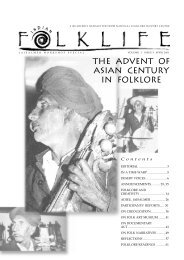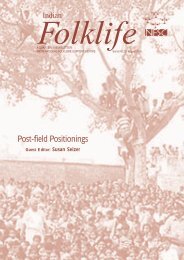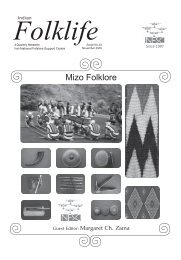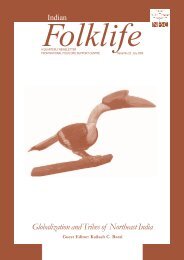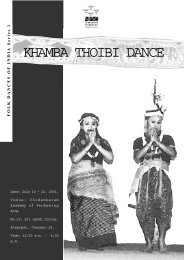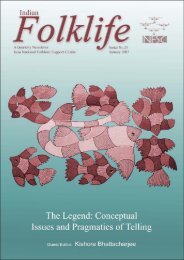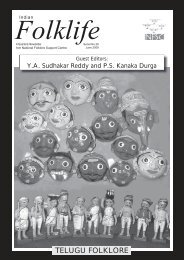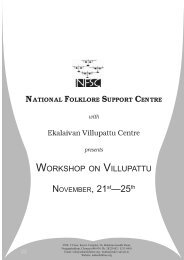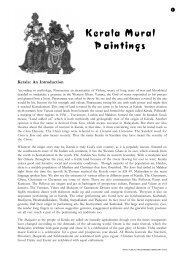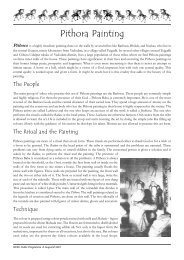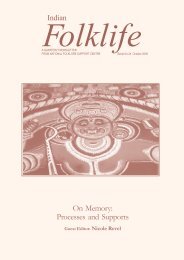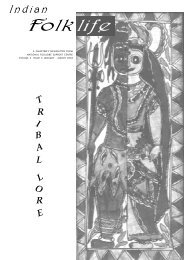Tripura Folklore - Wiki - National Folklore Support Centre
Tripura Folklore - Wiki - National Folklore Support Centre
Tripura Folklore - Wiki - National Folklore Support Centre
You also want an ePaper? Increase the reach of your titles
YUMPU automatically turns print PDFs into web optimized ePapers that Google loves.
5<br />
<strong>Tripura</strong> has great antiquity, ruled<br />
for thousands of years by kings<br />
who claim descent from the<br />
ancient king Yayati of the ‘lunar<br />
dynasty.’ There are references to<br />
the state in the Mahabharata. Yet,<br />
neither the precise location of its<br />
first establishment nor the source<br />
of its name can be identified<br />
beyond all doubts. The kingdom might have<br />
expanded, contracted or even shifted in those<br />
ancient days when migration to better lands<br />
and livelihood was quite common. The name<br />
might have also changed from Kiratadesha<br />
to Tribeg, to <strong>Tripura</strong>. The name <strong>Tripura</strong><br />
can be related to the tyrannical king Tripur<br />
destroyed by Shiva, or might have come down<br />
from the name of the guardian goddess of<br />
the state – Tripureswari. Or it could even be<br />
from the native expression ‘Twipra’, meaning<br />
confluence of rivers. The cultural heritage of<br />
the state is significant. It is of the nature of a<br />
mosaic. On the one hand, the ancient ethnic<br />
groups inherited and developed their cultural<br />
identity, on the other hand, the large number<br />
of Bengalis, Manipuris and others who settled<br />
later on the land, practised their own. A<br />
composite cultural scenario presents varied<br />
elements in co-existence.<br />
History does not pay even half the attention<br />
to artistic creations as it does to feats of fights;<br />
but fine arts and crafts are the most important<br />
documents of human civilisation and culture.<br />
The kings of <strong>Tripura</strong> were great patrons of art;<br />
many of them were themselves talented artists.<br />
<strong>Tripura</strong> can justifiably take pride in its cultural<br />
heritage of rock-sculpture. The ancient huge<br />
rock sculptures speak of an illustrious artistic<br />
past. In music, <strong>Tripura</strong> provided a congenial<br />
ground for practice and development of folk<br />
musical forms of different communities along<br />
with the development of classical music. In<br />
fact, there is a rich and varied heritage of<br />
folk musical songs among all the sections of<br />
the populace. As among other ancient ethnic<br />
groups in the North-east, ‘Jum’ or shifting<br />
cultivation was the usual practice among the<br />
indigenous people. The life pattern woven<br />
around the Jum was also the source of aesthetic<br />
activities like songs, music and oral literature.<br />
A man, even when he leaves his hearth and<br />
home behind, can seldom leave behind his<br />
cultural heritage held in oral literature; and<br />
as a man grows on a land, he grows with<br />
his tradition documented in the store of oral<br />
literature. Thus, the residents of different<br />
communities in the land have enriched its<br />
varied store of oral literature.<br />
Being the court language, writing in Bengali<br />
flourished in <strong>Tripura</strong> from the early sixteenth<br />
century. Rajmala (the history of <strong>Tripura</strong>-kings)<br />
is considered the oldest historical writing in<br />
Bengali. Members of the royal household<br />
followed literary pursuit in great earnest<br />
and many of them were literary artists of<br />
high order. From mid-nineteenth century<br />
the <strong>Tripura</strong> kings came in close contact with<br />
poet Rabindranath Tagore which added new<br />
vigour to Bengali literary practice in the state.<br />
Kokborok literature appeared in written form<br />
towards the middle of the last century; but<br />
there is reason to believe that there had been<br />
one which was lost. The original Rajmala<br />
(history of the kings) is said to have been<br />
composed in Kokborok, and later translated<br />
into Bengali. The late beginning of Kokborok<br />
written literature has been compensated by<br />
a rapid growth into maturity. It is largely<br />
because Kokborok literature has its foundation<br />
in the rich and varied ground of oral literature.<br />
Each ethnic community has its rich treasure<br />
of folk-lores that reflect its cultural pattern,<br />
social organisations, practices, ethical values<br />
and even self-identity. Mythical, legendary<br />
and historical past also remain contained<br />
in oral literary tradition. Even within this<br />
small state scholars find astonishing variety<br />
indicating the distinctive features of different<br />
ethnic groups. Some of the tales have identical<br />
elements. Common ways of life and identical<br />
or near identical cultural matrix of different<br />
communities can be one reason for this<br />
similarity, while the other most probable<br />
reason is that folk-tales always have some<br />
common characteristics like simplicity of tales,<br />
characters as types and focus on a particular<br />
issue. Division of the world into two clear<br />
hemispheres of good and evil and the role of<br />
man in it, /the outcome and the presence of<br />
the magical element are some other identical<br />
aspects. Only a comprehensive and methodical<br />
exploration of the vast and uncharted territory<br />
of <strong>Tripura</strong>-oral literature can provide any<br />
certain answer. The process of exploration<br />
is on, but there are<br />
yet many more ‘miles<br />
to go.’ ❆<br />
INDIAN FOLKLIFE SERIAL NO.35 JANUARY 2010



